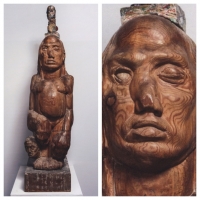14 Nov 2015
Balla’s Initial Idea
The house in Rome of Giacomo Balla (1871-1958), an Italian Futurist painter, is a kaleidoscope of color and creativity. I haven’t visited it but came across this photograph online of four of his clothes hangers. A commentator transcribes the h
26 Mar 2015
Ssh! The Secret of Picasso’s Ear
Ears make sense as one of the five: touch, taste, sight, sound and smell. But who thinks about Picasso's ears? We mostly remember his eyes: deep, dark and powerful. Yet he himself - as I don't think has been noted before - seems to have been very
14 Dec 2013
Winking in Art
Russian artists in the early 20th century turned to the West to absorb the latest trends happening in Paris. That’s the conventional story. Yet, little known, at the same time they were also turning eastwards towards Siberia and Russia’s ori
02 Oct 2013
Blindness Lets People See
"The blind can see" sounds like a biblical myth but it is true. The blind and the visually impaired can see visual art for what it is, at least the idea of it, while the sighted generally cannot. In paintings and sculptures over many centuries,
20 Apr 2013
Do you know what it means to come home?
Think differently. The old ways are often dull and didactic. Take, for instance, paintings and prints that seem to illustrate Bible stories. Why treat them as a narrative when mystical Christians, among whom must be counted many great Western ar
18 Feb 2013
1+1=1: The Divided Self in Manet’s Railway
What is the girl up to? Who are they? What's happening? Why do they wear the same color clothes? Why is the girl's hair so odd?
In my explanation two years ago of Edouard Manet’s The Railway (1873) I noted that the extended arm of the
10 Oct 2012 | 1 Comments
Art, Generalization and Sight
One of the keys to understanding art is generalization because many of the most creative artists donate their ideas not to contemporaries or to those in the generation afterwards, who might not even understand, but to other great artists centuri
The EPPH Blog features issues and commentary.







